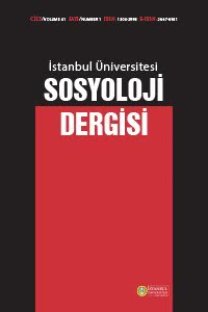Panel Data Analysis on the Socio-Economic Determinants of Corruption in the D-8 Countries
Corruption, Determinants of corruption, D-8 countries, Panel data analysis
Panel Data Analysis on the Socio-Economic Determinants of Corruption in the D-8 Countries
Corruption, Determinants of corruption, D-8 countries, Panel data analysis,
___
- Akça, H., Ata, A. Y., & Karaca, C. (2012). Inflation and corruption relationship: Evidence from panel data in developed and developing countries. International Journal of Economics and Financial Issues, 2(3), 281-295. google scholar
- Akçay, S. (2000). Yolsuzluk, ekonomik özgürlükler ve demokrasi. Muğla Üniversitesi Sosyal Bilimler Enstitüsü Dergisi, (1), 1-15. google scholar
- Al-Marhubi, F. A. (2000). Corruption and inflation. Economics Letters, 66(2), 199-202. google scholar
- Alsarhan, A. A. (2019). Determinants of corruption in Middle East countries: Evidence from panel data. International Journal of Economic Behavior and Organization, 7(4), 57-63. http://dx.doi. org/10.11648/j.ijebo.20190704.11 google scholar
- Baltagi, B. H. (2005). Econometrics analysis of panel data (3th ed.). John Wiley & Sons. google scholar
- Banerjee, A., Mullainathan, S., & Hanna, R. (2012). Corruption (No. w17968). National Bureau of Economic Research. Working Paper 17968. google scholar
- Bayar, G. (2010). Corruption in Turkey-an econometric enalysis. Erciyes Üniversitesi Sosyal Bilimler Enstitüsü Dergisi, 1(28), 105-131. google scholar
- Bitterhout, S., & Simo-Kengne, B. D. (2020). The effect of corruption on economic growth in the BRICS countries. A panel data analysis. University of Johannesburg, EDWRG Working Paper, 10-2022. google scholar
- Çelen, M. (2007). Yolsuzluk ekonomisi- kamusal bir kötülük olarak yolsuzluğun ekonomik analizi. İstanbul Serbest Muhasebeci ve Mali Müşavirler Odası Yayınları. google scholar
- Davies, A., & Lahiri, K. (1995). A new framework for testing rationality and measuring aggregate shocks using panel data. Journal of Econometrics, 68(1), 205-227. http://dx.doi.org/10.1016/0304-4076(94)01649-K. google scholar
- Farrales, M. J. (2005). What is corruption?: A history of corruption studies and the great definitions debate. (June 2005). http://dx.doi.org/10.2139/ssrn.1739962. google scholar
- Ghura, D. (1998). Tax revenue in Sub-Saharan Africa: Effects of economic policies and corruption (No. 98/135). International Monetary Fund. google scholar
- Greene, W. H. (2003). Econometric analysis. Prentice-Hall. google scholar
- Gründler, K., & Potrafke, N. (2019). Corruption and economic growth: New empirical evidence. European Journal of Political Economy, 60, 101810. google scholar
- Heritage Foundation. (2022). The heritage foundation. https://www.loc.gov/item/lcwaN0002695/. google scholar
- Hsiao, C. (2007). Panel data analysis—advantages and challenges. Test, 16(1), 1-22. http://dx.doi. org/10.1007/s11749-007-0046-x. google scholar
- Linhartova, V., & Halaskova, M. (2022). Determinants of corruption: A panel data analysis of Visegrad countries. Equilibrium. Quarterly Journal of Economics and Economic Policy, 17(1), 51-79. http://dx.doi.org/10.24136/eq.2022.003 google scholar
- Paldam, M. (1999). The Big Pattern of Corruption: Economics, Culture, and Seesaw Dynamics. Working Paper No: 11, Center for Dynamic Modelling in Economics, Department of Economics, University of Aarhus, Denmark. google scholar
- Piplica, D. (2011). Corruption and inflation in transition EU member countries. Ekonomska Misao I Praksa, 20(2), 469-506. google scholar
- Rehman, H. U., & Naveed, A. (2007). Determinants of corruption and its relation to GDP (A panel study). Journal of Political Studies, 12(2), 27-59. google scholar
- Sandu, S., & Ciocanel, B. (2014). Impact of R & D and Innovation on High-tech Export. Procedia Economics and Finance, 15, 80-90. google scholar
- Senaviratna, N. A. M. R., & Cooray, T. M. J. A. (2019). Diagnosing multicollinearity of logistic regression model. Asian Journal of Probability and Statistics, 5(2),1-9. http://dx.doi.org/10.9734/ ajpas/2019/v5i230132. google scholar
- Stephen. (1999, August 29). The Turkish quake’s secret accomplice: Corruption. New York Times, p. 3. google scholar
- Svensson, J. (2005). Eight questions about corruption. Journal of Economic Perspectives, 19(3), 19-42. google scholar
- Tanzi, V. (1998). Corruption around the world: Causes, consequences, scope, and cures. https:// www.imf.org/en/Publications/WP/Issues/2016/12/30/Corruption-Around-the-World-Causes-Consequences-Scope-and-Cures-2583 google scholar
- Topal, M. H., & Ünver, M. (2016). The determinants of corruption: A panel cointegration analysis for fragile economies. Balkan ve Yakın Doğu Sosyal Bilimler Dergisi, 2(2), 58-68. google scholar
- Tosun, U. (2003). Yolsuzluğun nedenleri üzerine ampirik bir çalışma. Akdeniz İktisadi İdari Bilimler Fakültesi Dergisi, 5, 125-146. google scholar
- Transparency International. (2019). What is corruption? https://www.transparency.org/what-is-corruption/#define (20.09. 2022). google scholar
- Transparency International. (2022a). Corruption Perceptions Index. https://www.transparency.org/ en/cpi/2021 (8.12.2022). google scholar
- Transparency International. (2022b). Corruption Perceptions Index Report 2021. CPI2021_Report_ EN-web.pdf (transparencycdn.org) (8.12.2022). google scholar
- UNODC. (2022). UNODC’s action against corruption and economic crime. https://www.unodc.org/ unodc/en/corruption/ google scholar
- Swaleheen, M., & Stansel, D. (2007). Economic freedom, corruption and growth. Cato Journal, 27(3), 343-358. google scholar
- Wooldridge, J. M. (2010). Econometric analysis of cross section and panel data. MIT Press. google scholar
- World Bank. (2021). Worldwide Governance Indicators. https://databank.worldbank.org/source/ worldwide-governance-indicators google scholar
- Yamak, N., Abdioğlu, Z., & Doğan, S. (2022). Determinants of corruption in the G20 countries: Panel ordered logit approach. Gazi İktisat ve İşletme Dergisi, 8(3), 501-512. google scholar
- ISSN: 1304-2998
- Yayın Aralığı: 2
- Başlangıç: 2020
- Yayıncı: İstanbul Üniv. Edebiyat Fak. Sosyoloji Böl.
Türk Milli Kimliğinde Alarmizm ve Devlet-Toplum Etkileşimi: Hatay-Belen Örneği
Üniversitelerde Araştırma Odaklı Yönetim Anlayışı: İstanbul Üniversitesi Örneği
Mahmut AK, Levent ŞAHİN, Eray YURTSEVEN
The Mental Health of a Society in Crisis: Complaints of Depression and Anxiety
Veysel BOZKURT, Hasan KAYA, Erol GÖKA, Kadriye Burcu ÖNGEN BİLİR
Panel Data Analysis on the Socio-Economic Determinants of Corruption in the D-8 Countries
The Validity and Reliability of The Turkish Version of The Social Curiosity Scale
Serdar KARAKULLUKÇU, Erdinç KARAKULLUKÇU, Betül BAL, Aysun KAZAK, Ayşe KARAKULLUKÇU
